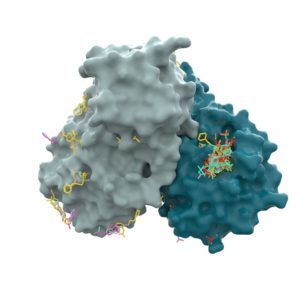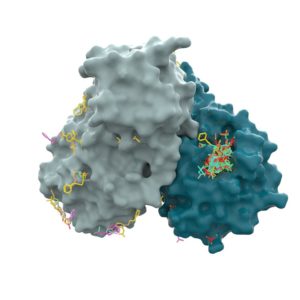In this special guest feature, Dr. Rosemary Francis writes that HPC is playing a massive part in the fight against Covid-19 through modeling, genomics, and drug discovery. This will only make the sector more essential to many industries.

Representation of the chemicals binding to the main protease of the SARS-CoV-2 virus – Copyright of Diamond Light Source Ltd
The virus that causes Covid 19 is known in the scientific community as SARS-CoV-2. Thanks to the work in labs and HPC centres around the world, we now know that the molecular mechanism of the SARS-CoV-2 entry is via a lock and key effect; a spike on the outside of the virus acts as a key to unlock an ACE2 receptor protein on the human cell. Then, the virus uses a second protein inside the cell – the TMPRSS2 protease – to finish its entry and to allow the virus to reproduce and transmit itself.
Diamond Light Source is the UK’s national synchrotron science facility and it has been turned over to the fight against SARS-CoV-2. The crystallography beamlines and electron microscopes have been important in understanding the structure of the proteins, potential weaknesses and in the search for suitable anti-viral drugs and vaccines.
Molecular docking through HPC
Simulating drug interactions at the molecular level is carried out through a process called molecular docking. Tens of thousands of natural compounds can be checked to see how they interact with the SARS-CoV-2 proteins. The docking process involves creating a prediction of the module structure and assessment of its affinity to bind to the virus.
To assess the potential of a drug, scientists must model the interactions over a variety of orientations, which is computationally expensive and highly parallel. By using HPC scientists can get answers within hours instead of months. The team at the Texas Advanced Computing Center (TACC) have been going a step further and using AI to accelerate and inform the search.
Single cell genomics is a Next Generation Sequencing technique that can isolate RNA from individual cells to differentiate between different cell types and how they function. RNA is the single stranded copy of DNA that is used to transport the DNA encoding around the cell to where proteins are assembled. By sequencing RNA instead of DNA it is possible to see which genes are active in the cell and to use that information to identify it and its functions. In the fight against SARS-CoV-2, the prevalence of the ACE2 receptor protein is an important indication of how vulnerable a cell is to SARS-CoV-2 infection.
The Human Cell Atlas project
Single-cell genomics is driving the work at the Human Cell Atlas (HCA). The HCA is an international collaborative consortium, between the Sanger Institute and other organizations around the globe. It aims to create comprehensive reference maps of all human cells and their functions. They have been looking at which cells are vulnerable to infection from SARS-CoV-2 to determine the areas of the body most likely to be the start of an infection. This work has been key to understanding how the virus enters via the nose and spreads to the lungs.
Scientists have also been able to track how the virus has been spreading through its mutations. By mapping the genome of tens of thousands of samples around the world, it is possible to see how the virus spreads and to build up a form of family tree. Importantly, it will allow doctors to differentiate between local and imported strains to track the efficacy of lockdown measures.
Iceland has long been a leader in genomics and HPC due to the combination of a genetically stable population and copious renewable power sources. Decode Genetics in Iceland has been able to determine where early infections came from and how they spread within the population by tracking mutations. They sequenced the virus from 643 different people following widespread testing and discovered that many early infections came from countries considered low risk at the time, such as Austria and Italy, as holiday makers returned from skiing trips. This mirrors what was seen in the media in the UK at the time and is an important discovery in understanding how epidemics spread.
While the HPC sector will welcome future growth from the life sciences sector, we also need to be mindful of the challenges faced by the industry going forward. Hopefully public understanding of the role compute plays in scientific discovery and medicine will address some of the talent shortfall that the HPC industry faces.
Dr. Rosemary Francis is CEO of Ellexus.





